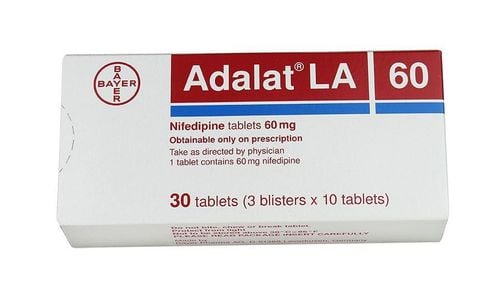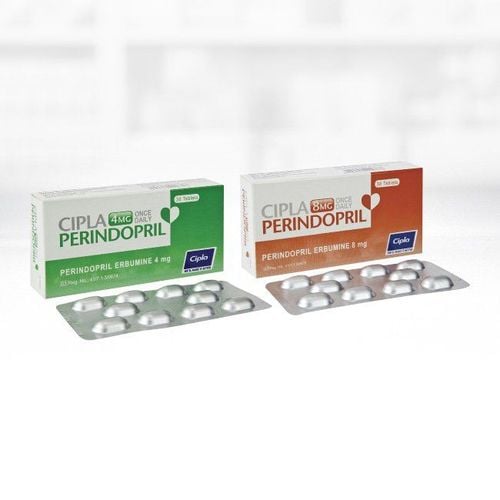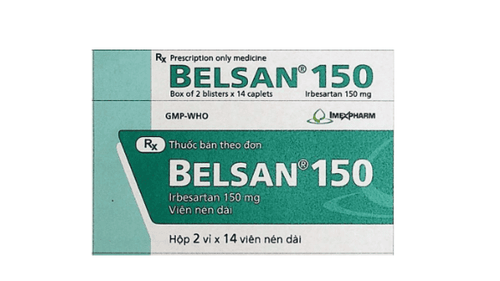This is an automatically translated article.
Viritin 4mg is indicated in the treatment of primary hypertension when blood pressure is not controlled with perindopril monotherapy. So what is the use of Viritin 4mg? What should be paid attention to when using the drug? Let's find out the necessary information about Viritin 4mg drug through the article below.
1. Uses of Viritin 4mg
Indications
Primary hypertension when blood pressure is not controlled with perindopril monotherapy.
Dosage - How to use
Dosage:
Adults: 1 tablet/day. Adjust dose according to patient and blood pressure response. If blood pressure is not adequately controlled, the dose may be increased to 2 tablets/day.
Elderly patients : Caution should be exercised when using preparations containing perindopril in elderly patients because of the often associated renal failure. The starting dose should be assessed based on the patient's blood pressure response and renal function. Dose reduction or monotherapy should be used and should be closely monitored during the initial phase of treatment. Caution should be exercised in elderly patients with congestive heart failure associated with renal and/or hepatic impairment.
Patients with renal failure:
+ Patients with severe renal impairment (creatinine clearance < 30ml/min): Contraindicated to use Viritin plus 2/0.625.
+ Patients with moderate renal impairment (creatinine clearance 30 - 60 ml/min): Reduce starting dose or use monotherapy.
+ Patients with creatinine clearance > 60 ml/min: No dose adjustment is required.
+ Periodically assess the patient's condition including serum creatinine and potassium levels.
Patients with liver failure:
+ Patients with severe liver failure: Contraindicated to use Viritin plus 2/0.625.
+ Patients with moderate hepatic impairment: No dose adjustment is required.
How to use:
Should be used on an empty stomach, before breakfast.
Overdose and management
Symptoms:
Electrolyte disturbances, hypotension, muscle weakness, gastrointestinal disturbances, nausea, vomiting, respiratory failure.
Treatment:
Symptomatic treatment, no specific antidote. Immediately gastric lavage or induce vomiting and immediately establish an intravenous line to administer isotonic saline. Perindopril is dialyzable (70 ml/min). Careful assessment of water and electrolyte balance is required after gastric lavage. Supportive treatment to maintain respiratory and circulatory function.
2. Note when using Viritin 4mg
Contraindications
Hypersensitivity to perindopril, indapamide or sulfonamide derivatives and any component of the drug. History of angioedema (Quincke's edema) associated with the use of ACE inhibitors. The patient recently had a cerebrovascular accident, anuria. Women who are pregnant or breastfeeding. Patients with severe renal impairment (creatinine clearance < 30 ml/min). Patients with severe liver failure, hepatic encephalopathy, hepatic coma. The patient has hypokalemia. Combined with antiarrhythmic drugs cause torsades de pointes. Note
Perindopril tert-butylamine:
In case of heart failure, loss of salt and water, ... risk of hypotension and/or renal failure (complete diet and/or diuretic therapy), renal artery stenosis,. ..When taking ACE inhibitors can cause hypotension, especially at the first dose and during the first 2 weeks of treatment, and/or severe renal dysfunction, sometimes acute, although rare and lasting for a short period of time. non-fixed space. Therefore, when starting treatment, some of the recommendations below should be followed, in some special cases, as follows:
+ In hypertension with pre-diuretic treatment, it is necessary to: discontinue the diuretic. urinate at least 3 days before starting perindopril, then restart if necessary. If discontinuation is not possible, treatment should be initiated at a dose of 2 mg.
+ In renal arterial hypertension, treatment should be initiated at a low dose of 2 mg (see Renal Vascular Hypertension).
+ Serum creatinine should be assessed before starting treatment and during the first month of treatment. In congestive heart failure treated with diuretics, the diuretic dose should, if possible, be reduced several days before initiating perindopril.
+ In at-risk populations, especially those with severe congestive heart failure (grade IV), the elderly, patients initially with very low blood pressure or impaired renal function, or patients taking diuretics For high doses, start with a low dose of 1mg, under medical supervision.
Hemodialysis: Anaphylactoid-like reactions (edema of the lips and tongue with dyspnea and hypotension) have been reported during hemodialysis with a highly permeable membrane (polyacrylonitrile) in patients treated with the drug. inhibitory enzymes. This combination should be avoided. Renal impairment: Perindopril dose should be adjusted according to the degree of renal impairment. In these patients, serum potassium and creatinine should be checked periodically. Renal Vascular Hypertension: Renal vascular hypertension must be treated with vascular remodeling. However, perindopril may be useful for patients with renal vascular hypertension awaiting orthopedic surgery or when surgery is not possible. At that time, treatment should be initiated cautiously and renal function monitored. Children: because there are no studies in children, to the present knowledge, perindopril is contraindicated for use in children. Elderly: treatment should be initiated at a dose of 2 mg once daily, and renal function should be assessed before initiating therapy. Surgical intervention: in the case of major surgery, or induction of anesthesia with drugs that can cause hypotension, perindopril can cause hypotension. Congestive Heart Failure: In patients with mild to moderate congestive heart failure, no significant change in blood pressure was observed with an initial dose of 2 mg. However, in patients with severe congestive heart failure and in patients at risk, a low dose should be initiated. Indapamide:
Severe kidney disease: promotes hypernitremia. If kidney damage progresses, indapamide should be discontinued. Hepatic impairment: Indapamide should be used with caution in patients with hepatic impairment or with advanced liver disease, particularly when serum potassium is reduced, as drug-induced fluid and electrolyte imbalances may precipitate hepatic coma. Hyperparathyroidism or Thyroid Diseases: If hypercalcaemia and hypophosphataemia occur during indapamide use, the drug must be discontinued before conducting a parathyroid function test. Patients with sympathectomy: increased risk of hypotension with indapamide use. Indapamide may worsen lupus erythematosus. Periodic determination of blood glucose levels, especially in patients with known or suspected diabetes mellitus. Caution
Operating vehicles, machinery
Viritin plus 2/0.625 may cause dizziness or drowsiness. Use drugs with caution when operating vehicles and machinery.
Pregnancy
Do not use the drug for pregnant and lactating women.
3. Side effects of Viritin 4mg
Common : headache, dizziness, dizziness, mood and/or sleep disturbances, asthenia; at the start of treatment inadequately controlled blood pressure; digestive disorders, loss of appetite, nausea, vomiting; cramps, muscle weakness, local rashes on the skin; dry cough, irritation pattern; electrolyte and fluid disturbances.
Uncommon: impotence, dry mouth; a slight decrease in hemoglobin at the start of treatment; hyperkalemia (due to perindopril) or hypokalemia (due to indapamide), increased blood urea, serum creatinine and reversible upon discontinuation of therapy; orthostatic hypotension, palpitations; rash, pruritus, urticaria.
Rare: angioedema (Quincke's edema) of the face, extremities, lips, tongue, glottis and/or larynx; thrombocytopenia, agranulocytosis; acute myopia.
4. Drug interactions
Perindopril tert-butylamine:
Agents reduce the effect: non-steroidal anti-inflammatory drugs, corticosteroids, tetracosactide. Intensifiers: In some patients with pre-existing diuretics, especially when recently started, the antihypertensive effect may become excessive once perindopril is started. Sedatives and antidepressants imipramine: increased risk of orthostatic hypotension when combined with perindopril. Antidiabetic drugs (insulin, hypoglycemic sulphonamides): Perindopril enhances the hypoglycemic effect of these drugs. Agents that increase toxicity: Co-administration of perindopril with potassium salts and with potassium-sparing diuretics carries a risk of hyperkalemia and renal failure. Drugs that cause hyperkalemia should not be combined with ACE inhibitors, except in cases of hypokalemia. However, if this combination proves necessary, it should be used with caution and with frequent evaluation of serum potassium. Lithium: Increased blood lithium. Digoxin: No pharmacokinetic interaction was observed when perindopril was co-administered with digoxin. There is no need to change the dose of digoxin in case of co-administration in patients with congestive heart failure. Indapamide:
Diuretics: cause hypokalemia and hyperuricemia when used in combination with indapamide. Lithium: Indapamide reduces renal clearance of lithium, thereby increasing the risk of lithium toxicity. Vasoconstrictor (noradrenalin): Indapamide reduces the arterial response to vasoconstrictors such as noradrenaline, but the reduction is not sufficient to prevent the therapeutic effect of noradrenaline. Store
In a dry place, below 30°C. Avoid light.
Please dial HOTLINE for more information or register for an appointment HERE. Download MyVinmec app to make appointments faster and to manage your bookings easily.













